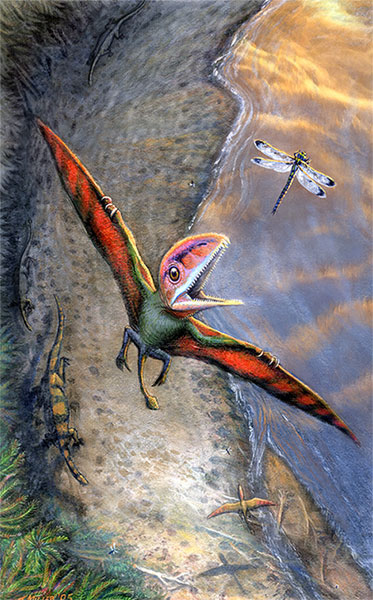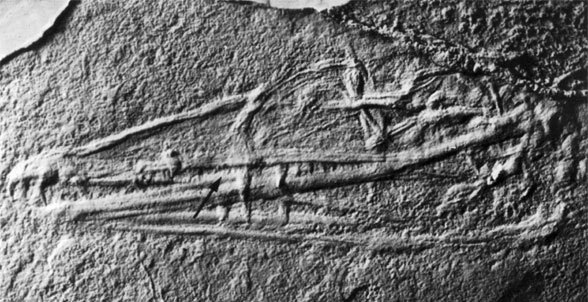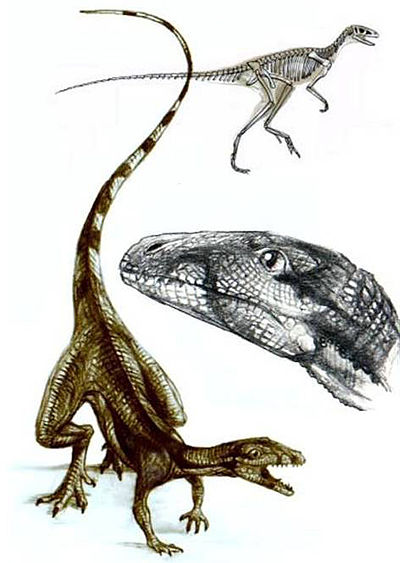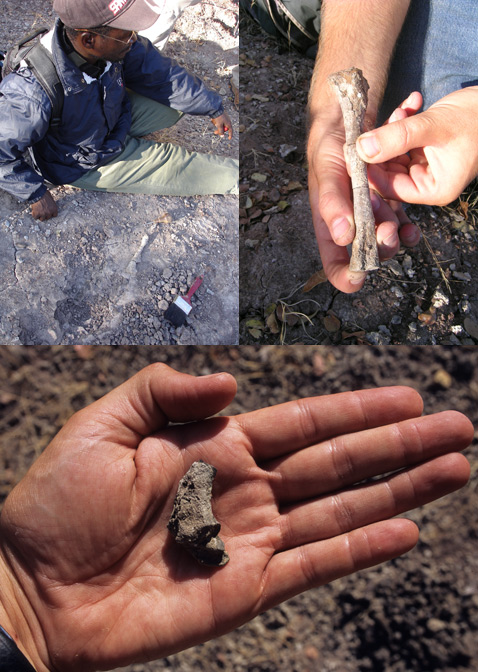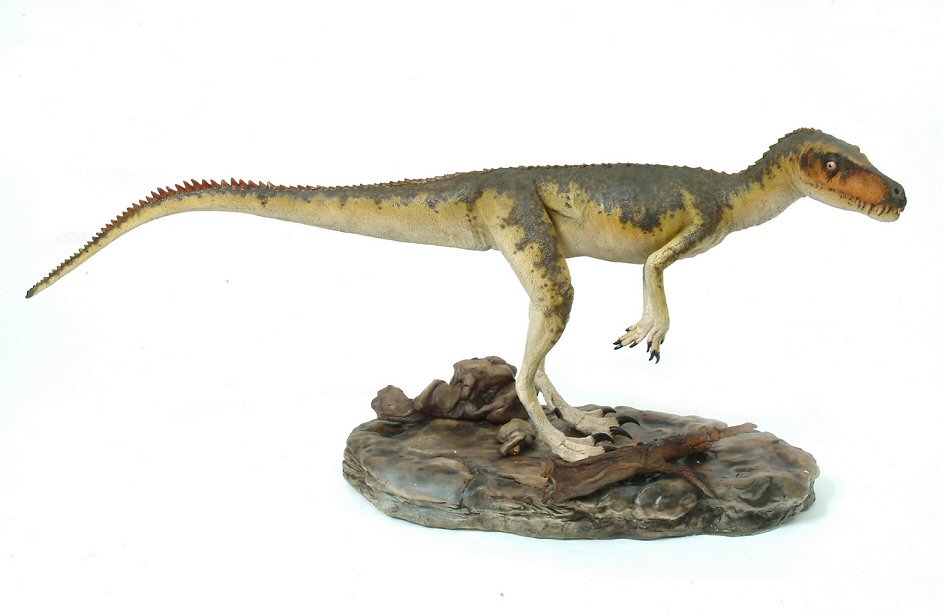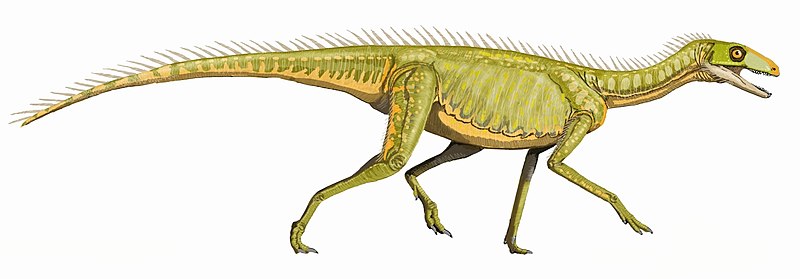[Recent Entries][Archive][Friends][User Info]
March 10th, 2012
| March 10th, 2012 | |
|---|---|
| 12:23 pm [industrialterro] [Link] |
Peteinosaurus Peteinosaurus (pronounced /pɛˌtaɪnəˈsɔrəs/ or /pɛˌtinəˈsɔrəs/) was a prehistoric reptile genus belonging to the Pterosauria. It lived in the late Triassic period in the middle Norian (about 221-210 million years ago). Three fossils have been found near Cene, Italy. The first fossil, the holotype MCSNB 2886, is fragmentary and disarticulated. The second, the articulated paratype MCSNB 3359, lacks any diagnostic features of Peteinosaurus and thus might be a different species. This paratype has a long tail (20 cm) made more stiff by long extensions of the vertebrae; this feature is common among pterosaurs of the Triassic. The third exemplar is MCSNB 3496, another fragmentary skeleton. All specimina are those of subadults and of none has the skull been preserved. Like most pterosaurs, Peteinosaurus had bones that were strong but very light. Peteinosaurus is trimorphodontic, with three types of conical teeth. An insectivorous lifestyle has been attributed to Peteinosaurus. The fifth toe of Peteinosaurus was long and clawless. Its joint allowed it to flex in a different plane than the other phalanges, an adaptation whose function is unknown. Peteinosaurus is one of the oldest-known pterosaurs, and at a mere sixty centimetres, had a tiny wingspan when compared to some later genera, such as Pteranodon whose wingspan exceeded twenty feet. Its wings were also proportionally smaller than those of later pterosaurs, as its wing length was only twice the length of the hindlimb. All other known pterosaurs have wingspans at least three times the length of their hindlimbs. It also had single cusped teeth that lacked the specialized heterodonty present in the other Italian Triassic pterosaur genus, Eudimorphodon. All these factors converge to hint that Peteinosaurus belongs to a group that possibly represents the most basal known pterosaurs: the Dimorphodontidae, to which it was assigned in 1988 by Robert L. Carroll. The only other known member of that group is the later genus Dimorphodon, which lent its name to the family including both genera. Later cladistic analyses however, have not shown a close connection between the two forms. Nevertheless the possible basal position of Peteinosaurus has been affirmed by Fabio Marco Dalla Vecchia who suggested that Preondactylus, according to David Unwin the most basal pterosaur, might be a subjective junior synonym of Peteinosaurus. A 2010 cladistic analysis by Brian Andres and colleagues placed Peteinosaurus in Lonchognatha which includes Eudimorphodon and Austriadactylus as more basal.
Tags: Вымершие рептилии, Триас, авеметатарзалии, архозавроморфы, архозавры, диапсиды, диморфодонтиды, птерозавры, рамфоринхоидеи |
| Time | Event |
| 12:42 pm [industrialterro] [Link] |
Preondactylus Preondactylus is a genus of long-tailed pterosaur from the Late Triassic that inhabited what is now Italy. It was discovered by Nando Buffarini in 1982 near Udine in the Preone valley of the Italian Alps. Preondactylus had single cusp teeth, meaning they had one point on each tooth. Its diet either consisted of fish, insects or both, but there is still debate going on as the tooth structure could indicate either diet (or both). It had short wings, whose total span was only 45 cm (18 in), and relatively long legs. The short wings were a "primitive" feature for pterosaurs, but Preondactylus was a fully developed flier. When Buffarini first discovered Preondactylus, the thin slab of bituminous, dolomitic limestone containing the fossil was accidentally broken into pieces while being extracted. After reassembly the rock was cleaned with water by him and his wife and the marl and in it the bone was washed away and lost. All that was left was a negative imprint on the stone, of which a silicon rubber cast was made to allow for subsequent study of the otherwise lost remains. Most of the skeleton is known, but the posterior portions of the skull have not been preserved. This first specimen is the holotype: MFSN-1891. A second, disarticulated specimen, MFSN-1770, was found at the same locale in 1984 about 150-200 meters deeper into the strata than the original find. The second specimen appears to have been preserved in the gastric pellet of a predatory fish, which had consumed the pterosaur and vomited up the indigestible pieces that would later fossilize. More detailed knowledge of the variability of Triassic pterosaurs has made the identification of this specimen as Preondactylus uncertain. A third specimen is MFSN 25161, a partial skull, lacking the lower jaws. The species was described and named by Rupert Wild in 1984. The genus name refers to Preone, the specific name honours Buffarini. Rupert classified the new species within Rhamphorhynchidae, of which group very old species are known such as Dorygnathus, but soon it was understood the form was much more basal. A cladistic analysis by David Unwin found Preondactylus as the most basal pterosaur, and the species was accordingly used by him for a node clade definition of the clade Pterosauria. Other analyses however, have found a somewhat more derived position for Preondactylus.
Tags: Вымершие рептилии, Триас, авеметатарзалии, архозавроморфы, архозавры, диапсиды, птерозавры, рамфоринхоидеи |
| Time | Event |
| 01:01 pm [industrialterro] [Link] |
Dromomeron Dromomeron (meaning "running femur") is a genus of lagerpetonid dinosauromorph archosaur from Late Triassic-age rocks of the Southwestern United States. It is known from partial remains, largely from the hindlimbs, which indicate an animal with an overall length of less than 1.0 meters (3.3 ft). It is described as most closely related to the earlier Lagerpeton of Argentina, but was found among remains of true dinosaurs like Chindesaurus, indicating that the first dinosaurs did not immediately replace related groups. Dromomeron and type species D. romeri is based on GR 218, a complete left thigh bone from the Hayden Quarry at Ghost Ranch, New Mexico. The rocks there are in the lower portion of the Petrified Forest Member of the Chinle Formation, and are Norian in age. Additional hindlimb bones, some probably from the same individual, are also known, and a partial skeleton has been recovered from Hayden Quarry, but has not yet been fully prepared. A few other specimens have been recovered from nearby localities, including the Snyder Quarry. The bones of Dromomeron are most similar to those of the older dinosauromorph Lagerpeton, and the two animals have been classified together in a clade Lagerpetonidae. The species name romeri honors influential 20th century vertebrate paleontologist Alfred Sherwood Romer. Also found at the Hayden Quarry are the remains of phytosaurs, aetosaurs, rauisuchians, and several types of dinosaurs and dinosaur relatives, including a Silesaurus-like animal, the herrerasaurid Chindesaurus, and an unnamed coelophysoid theropod. Finding the remains of four types of dinosaurs and dinosaur relatives (including Dromomeron itself) is noteworthy because it shows that dinosaurs did not immediately replace related groups; that some of these groups, like the lagerpetonids, persisted for longer than previously known and diversified; and that dinosaurian replacement may have occurred at different times in different areas. Other specimens from the Chinle Formation of Arizona and a roughly contemporaneous part of the Dockum Group of Texas also have been assigned to this genus. These have been assigned to second species D. gregorii, named in 2009. D. gregorii, named for Joseph T. Gregory, is based on TMM 31100–1306, a right femur (thigh bone) from the Otis Chalk Quarry, Colorado City Formation, (Dockum Group), near Otis Chalk, Texas. Several other limb bones from the quarry, and a partial femur (thigh bone) from the Placerias Quarry of eastern Arizona have been assigned to this species. The rocks D. gregorii is known from are older than those D. romeri has been found in. As with D. romeri, the Otis Chalk Quarry also has at least one specimen of the early dinosaur Chindesaurus. The Lagerpetonidae (LAJ•er•pet•ON•ih•DÆ) is a family of basal dinosauromorphs. Members of the family are known from the Late Triassic of Argentina, Arizona, New Mexico, and Texas. Lagerpetonids are defined as being rather small (length of one hind limb being 25 centimetres (9.8 in)), with "very marked locomotor specializations", final presacral and anteriorly oriented vertebrae, a sacral including two vertebrae, a closed acetabulum, and an up facing ilium". They had a short and wide pubis, and had an ischium with extensive ventral lamina. In relation to the genus Lagosuchus, the genera had shorter thigh bones than shins. Динозавроморфы (Dinosauromorpha) — группа вымерших архозавров, близких к динозаврам, живших в триасовом периоде на территории Европы, Северной и Южной Америки. В некоторых классификациях к этой группе также относятся и сами динозавры. Название кладе дано M. J. Benton в 1985 году, которую он отнес к группе Neoarchosauria. Однако через год, в 1986 году, Жаком Готье динозавроморфы были отнесены в новую кладу — Ornithodira. Впоследствии остальные ученые поддержали данный таксон. Ныне таксономическое положение Neoarchosauria не определено. Базальные динозавроморфы не являлись непосредственными предками динозавров. Ранее предполагалось, что динозавроморфы вымерли в то время, когда начался быстрый расцвет динозавров. Однако найденные останки примитивных динозавроморф вместе с останками первых динозавров, в отложениях триаса в штате Нью-Мексико, дает основание полагать, что базальные динозавроморфы и динозавры сосуществовали одновременно. По-видимому, в триасе динозавры выдержали долгую конкуренцию с динозавроморфами, прежде чем победили и достигли расцвета в юрском периоде. Также палеонтологи предполагали, что все предки динозавров и их ближайшие родственники из группы динозавроморфных рептилий в начале и середине триаса были хищниками и, преимущественно, двуногими. Но открытие силезавров и обнаружение Asilisaurus kongwe показало, что экологическое разнообразие внутри группы орнитодир (Ornithodira) в триасе было значительно большим. Ornithodira (Avemetatarsalia) — клада в рамках более широкой группы архозавров. В 1986 году Жак Готье дал название Ornitodira, содержащей общих предков динозавров, птерозавров и их ближайших родственников. В 1991 году Пол Серено дополнил кладистику и включил в нее Scleromochlus и расширил таким образом кладу Готье. Однако в 1999 году Майкл Бентон пришел к выводу, что Scleromochlus не родственен с другими животными клады Ornithodira. В 2004 году Бентон дал более чёткое определение клады Ornithodira.
Tags: Вымершие рептилии, Триас, авеметатарзалии, архозавроморфы, архозавры, диапсиды, динозавроморфы, лагерпетониды |
| Time | Event |
| 01:21 pm [industrialterro] [Link] |
Marasuchus Маразух (Marasuchus) — вымерший род архозавров отнесенный к кладу орнитодиры, живший в среднем триасе. Является ближайшим родственником динозавров. Окаменелости были обнаружены в Аргентине (Южная Америка). В длину достигал до 1,3 метров. В строении скелета этой рептилии много общих с динозаврами особенностей. Например, передние лапы у маразуха были почти вдвое короче задних. Лёгкий и, вероятно, очень проворный, маразух мог передвигаться на двух задних ногах не хуже, чем на всех четырёх. Питался он, по-видимому, мелкими рептилиями и насекомыми.
Tags: Вымершие рептилии, Триас, авеметатарзалии, архозавроморфы, архозавры, диапсиды, динозавроморфы |
| Time | Event |
| 01:30 pm [industrialterro] [Link] |
Lagosuchus Лагозух (Lagosuchus) — древнее животное, обитавшее в триасовый период. Часть учёных считает его связующим звеном, от которого произошли такие динозавры, как один из самых первых — ставрикозавр. Название, придуманное американским палеонтологом Альфредом Шервудом Ромером (1894—1973), означает «прыгающий крокодил». Его окаменелости были обнаружены в Ла-Риохе (Аргентина). Лагозух был размером с кролика, а также схож с ним строением задних конечностей. Передние конечности Лагозуха приспособлены для захвата добычи. По другим характеристикам схож с динозаврами, имел длинный тонкий хвост и длинные ноги, что свидетельствует о том, что он мог быстро и прытко перемещаться. Лагозухи были хищниками, питались всевозможными насекомыми. Возможно, они также были способены набрасываться на небольших животных, используя свои длинные задние конечности, которые с большой скоростью толкали их вперед. Когда лагозух быстро бежал, он, по всей видимости, опирался лишь на задние конечности, но иногда передвигался и на всех четырёх. Возможно, лагозух был настолько проворным, что мог забираться на деревья, когда ему грозила опасность, и иногда заходить в неглубокую воду, хотя не имеется никаких признаков того, что он хорошо плавал. В триасовом периоде, когда жил лагозух, вся суша представляла собой единый гигантский сверхматерик Пангею, климат был жарким и шли проливные дожди, за исключением внутренних районов, где образовались пустыни. Основной растительностью являлись гинкго, саговники, хвойные деревья, хвощи и папоротники.
Tags: Вымершие рептилии, Триас, авеметатарзалии, архозавроморфы, архозавры, диапсиды, динозавроморфы |
| Time | Event |
| 01:50 pm [industrialterro] [Link] |
Asilisaurus Asilisaurus ( Fossils were uncovered in Tanzania and date back to the Anisian stage of the Middle Triassic. It was described in 2010 by a team of researchers from the United States, Germany, and South Africa, in the journal Nature; the type species is A. kongwe. It is the first example of an avian-line radiation during the Anisian, with the diversification of archosaurs during this time previously only documented from crocodylian-line archosaurs. It was the first non-dinosaurian dinosauriform recovered from Africa. Asilisaurus measured from 1 to 3 metres (3 to 10 ft) long and 0.5 to 1 metre (2 to 3 ft) high at the hip, and weighed 10 to 30 kilograms (20 to 70 lb). Ученые нашли окаменелые останки самого древнего животного, образующего с динозаврами одну эволюционную ветвь, что говорит о более раннем, примерно на 10-15 миллионов лет, отделении предков динозавров от других типов животных, обитавших на доисторической Земле, сообщается в статье исследователей, опубликованной в четверг в журнале Nature. Обнаруженный вид животных получил название Asilisaurus kongwe - от asili ("предок" или "основание" на языке суахили), sauros ("ящер" на греческом ) и kongwe ("древний" на языке суахили). Он относится к животным из не так давно открытой группы силезавров (silesaurs), состоящих примерно в таком же родстве с динозаврами, в каком человек состоит с самыми близкими своими родственниками - шимпанзе. Асилизавр, по мнению ученых, жил примерно 243 миллиона лет назад, тогда как останки самого древнего динозавра, обнаруженные на данный момент, имеют возраст всего 230 миллионов лет. Это говорит о том, что общий предок динозавров отделился от остальных примитивных ящеров, потомками которых являются, например, современные крокодилы, существенно раньше, чем считалось прежде - около 250 миллионов лет назад. Асилизавры жили бок о бок с динозаврами на протяжении всего триасового периода - с 250 до 200 миллионов лет назад. Ученые теперь полагают, что другие родственники динозавров, такие, например, как летающие ящеры, тоже появились раньше, чем принято считать. Асилизавры были распространены на всех континентах мира, составлявших тогда единый суперматерик Пангею. Ведя раскопки в Танзании, авторы статьи - группа палеонтологов во главе со Стирлингом Несбиттом (Sterling Nesbitt) из Техасского университета в США, обнаружили останки сразу 14 особей асилизавров. Это позволило ученым практически полностью восстановить облик древнего родственника ископаемых рептилий. Асилизавр передвигался на четырех конечностях, был небольших размеров - не более 3 метров от кончика носа до кончика длинного хвоста, составлявшего до половины длины всего тела, и весил от 10 до 30 килограммов. У него была вытянутая морда с нижней челюстью, снабженная заостренным ороговевшим кончиком и рядом треугольных зубов. Авторы статьи полагают, что характерные черты асилизавра указывают на то, что это было травоядное или всеядное животное. До сих пор палеонтологи считали, что наиболее близкие предки динозавров были сугубо хищными животными и передвигались на двух лапах. "Асилизавр несет на себе черты, сильно отличающиеся от тех, что мы ожидали увидеть у родственника первых динозавров, особенно это касается его способности употреблять растительную пищу и перемещаться на четырех лапах", - сказал соавтор публикации Рэнделл Ирмис (Randall Irmis) из Университета Юты, слова которого приводит пресс-служба учебного заведения. Тот факт, что общие предки асилизавров и динозавров были сугубо хищными животными, указывает на три различных независимых пути эволюции и появления травоядных среди этих групп животных в течение всего 10 миллионов лет. Другими группами животных, освоившими питание растениями в этот период времени, были птицетазовые динозавры и динозавры из группы зауроподоморфов. Ученые полагают, что способность питаться растительной пищей дала животным эволюционные преимущества перед конкурентами, так как экосистема тех времен была представлена в основном хищниками, находившимися друг с другом в сильной конкуренции. Останки асилизавров были обнаружены среди останков других типов животных - примитивных родственников современных крокодилов, что говорит о более раннем и быстром разделении эволюционных ветвей этих животных, чем считалось прежде. "Наше исследование заставляет предположить, что в то время, примерно 250 миллионов лет назад, существовало больше групп животных, которые нам еще предстоит обнаружить. Чем больше мы о них узнаем, тем больше мы понимаем о появлении и эволюции самих динозавров и других групп животных", - подытожил Ирмис. Значимость открытия Asilisaurus kongwe не только в том, что он проливает свет на раннюю эволюцию силезавров, но и в том, что он позволяет лучше понять эволюцию всей группы динозавроморфных архозавров. Ранее палеонтологи предполагали, что все предки динозавров и их ближайшие родственники в начале и середине триаса были хищниками и, преимущественно, двуногими. Но открытие силезавров и вот теперь обнаружение Asilisaurus kongwe показало, что экологическое разнообразие внутри группы орнитодир (Ornithodira) в триасе было значительно большим. Здесь необходимо пояснить, что орнитодиры – большая группа архозавров, в которую ученые объединяют птерозавров, динозавроморфных архозавров, а некоторые – сторонники теории происхождения птиц от динозавров - добавляют в нее и птиц. The fossils range in age from the Anisian to the Norian stages of the Triassic, about 245 to 203 million years ago. Among the members of the Silesauridae were Silesaurus (which lends its name to the family), Pseudolagosuchus, Lewisuchus, Asilisaurus, Technosaurus, Eucoelophysis, Sacisaurus, and Diodorus.
Размеры тела в сравнении с человеком:
Tags: Вымершие рептилии, Триас, авеметатарзалии, архозавроморфы, архозавры, диапсиды, динозавроморфы, силезавриды |
| Time | Event |
| 02:16 pm [industrialterro] [Link] |
Lewisuchus Lewisuchus is a genus of archosaur that lived during the Middle Triassic (Ladinian); it was a silesaurid dinosauriform, a member of the group of reptiles which lead to the dinosaurs. Lewisuchus was about three feet long. Fossils have been found in Argentina. Some of the fossils originally assigned to Lewisuchus have since been moved to other genera, and the remaining portions closely resemble those of Pseudolagosuchus. A 2010 study in the Journal Nature indicated that the two may be synonymous. They were approximately the same size and came from the same locality and strata, but the fossil material is fragmentary and there is very little overlapping material. Since Lewisuchus was described 15 years before Pseudolagosuchus, if it is shown the two are synonymous (through the discovery of additional fossils) the name Lewisuchus would have priority.
Tags: Вымершие рептилии, Триас, авеметатарзалии, архозавроморфы, архозавры, диапсиды, динозавроморфы, силезавриды |
| Time | Event |
| 02:21 pm [industrialterro] [Link] |
Sacisaurus Sacisaurus (referred to in Portuguese as sacissauro) is a dinosauriform from the Late Triassic (Carnian to Norian) Caturrita Formation of southern Brazil. The scientific name refers to the city where the Sacisaurus was found, Agudo in the Rio Grande do Sul state and to Saci, a famous one-legged elf from Brazilian mythology, because the fossil skeleton has been found missing a leg. It was discovered in the geopark of Paleorrota. Sacisaurus was 1.5 meters (5 ft) long and 70 centimeters (2.3 ft) high. Its long and strong legs indicate that it was a fast animal. According to Jorge Ferigolo, paleontologist of Zoobothanic Foundation of Rio Grande do Sul state, the biggest teeth of the genus were 3 millimeters (1/12 in) long. The well-preserved jaw indicates that Sacisaurus was an herbivore, and there is a process at the tip that resembles the ornithischian predentary bone. Further research will attempt to define if Sacisaurus was the oldest ornithischian dinosaur. Through the cladistic analysis of some of its morphological particularities, its closest relative may be Diodorus. Sacisaurus was discovered in 2001 in the small municipality of Agudo, in the countryside of Rio Grande do Sul state. Through 50 bones, scientists could assemble the skeleton and speculate on how it might have lived. The fossil was presented for the first time in the 2nd Latin American Congress of Vertebrate Paleonthology in 2005. After the work of Brazilian scientists, the announcement of the discovery of the new species was made on November 1, 2006 at the University of São Paulo, Ribeirão Preto, where the bones were identified and the paper was published in the British scientific journal Historical Biology: A Journal of Paleobiology on October 30, 2006. The discovery helped scientists to study the feeding habits of dinosaurs and their close relatives, since it is one of the oldest ever found.
Tags: Вымершие рептилии, Триас, авеметатарзалии, архозавроморфы, архозавры, диапсиды, динозавроморфы, силезавриды |
| Time | Event |
| 02:33 pm [industrialterro] [Link] |
Silesaurus Silesaurus is a genus of dinosauriform from the Late Triassic, approximately 230 million years ago in the Carnian faunal stage of what is now Poland. Fossilized remains of Silesaurus have been found in the Keuper Claystone in Krasiejów near Opole, Silesia, Poland, which is also the origin of its name. The type species, Silesaurus opolensis, was described by Jerzy Dzik in 2003. It is known from some 20 skeletons, making it one of the best-represented of the early dinosaurs and related animals. Silesaurus measured approximately 2.3 meters long (7.5 ft), and was facultatively bipedal. It was light and built for speed. Silesaurus was a herbivore. The teeth were small, conical, and serrated. The tip of the dentary has no teeth, and some paleontologists think that it may have been covered by a beak. Most scientists think that Silesaurus was not a dinosaur, but rather a dinosauriform. Dinosaurian features lacking in Silesaurus include an enlarged deltopectoral crest (a muscle attachment on the humerus), and epipophysis (enlarged tendon attachment above the postzygapophysis) on the cervical vertebrae. However, Silesaurus has some dinosaurian characteristics as well:
As a result, alternative theories place Silesaurus at or near the base of the ornithischian dinosaurs. Other scientists propose a basal link between the prosauropods and ornithischians.
Tags: Вымершие рептилии, Триас, авеметатарзалии, архозавроморфы, архозавры, диапсиды, динозавроморфы, силезавриды |
| Previous Day | 2012/03/10 [Archive] |
Next Day |

